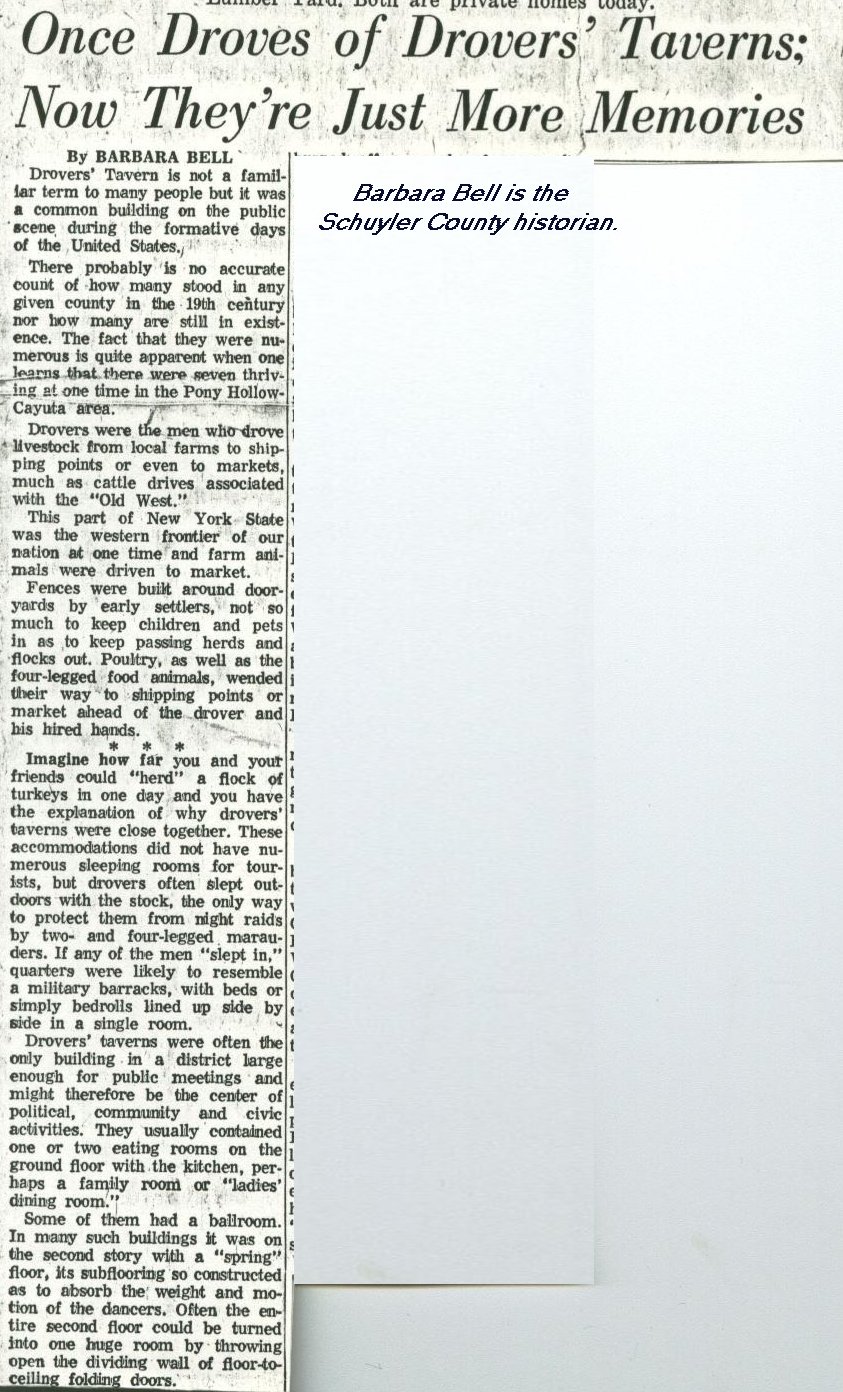
THE HALFWAY HOUSE
Fred Dann's house
Fred Dann moved south on the Ridge Road from the Worden Farm to a larger home which came with the purchase of the Vary farm in 1916. This property was originally settled by Harvey Turner, and through the years the house was built and expanded so that it also served as a roadside inn for a number of years. It was locally known as "The Halfway House" because it was approximately half way between Elmira and Odessa. In the earliest years, the Ridge Road connected Elmira to the Catskill Turnpike which ran west through Ithaca and Watkins to Bath. The upper stretch of road, from Odessa to the turnpike (now route 79) is still called the "Newtown Road"; Newtown being an early name for Elmira.
Below is a newspaper clipping on "drover's taverns" which helps explain the need for a roadside inn... in what seems to be "in the middle of nowhere". As an aside however, the section of Ridge Road around the halfway house was once the hamlet of Veteran, and had a US post office.

From every account, the house was huge, with a large kitchen, dining room, and front room. There were six bedrooms upstairs and a large "ballroom" which extended to the rear, over the woodshed. There was a pump organ in the ballroom.
Below are diagrams of the house, drawn to the best of Jim Dann's recollection (he was about ten years old when it burned). My mother, Virginia Dann, made a similar sketch which included the radio along the right- side wall of the family room and a "pot belly stove" on the left wall. She is older than Jim, but only visited the house from Painted Post a few times a year. She remembers Art and Dorothy Bullock rooting for different sides of the Penn State- Cornell football game, on the radio "every" Thanksgiving. Jim recalls that there were "two or three overstuffed davenports and chairs in the front room. The room was large.
Jim and I talked at length about the house and some of the routines of living in it. Its use underwent continuous changes as family members got married and moved away or moved in as a separate household. One census record shows three Dann households under the one roof.
Something worth considering is that the Dann family was successful at farming, yet they and their neighbors lived in conditions that would be unacceptable for habitation by today's standards.
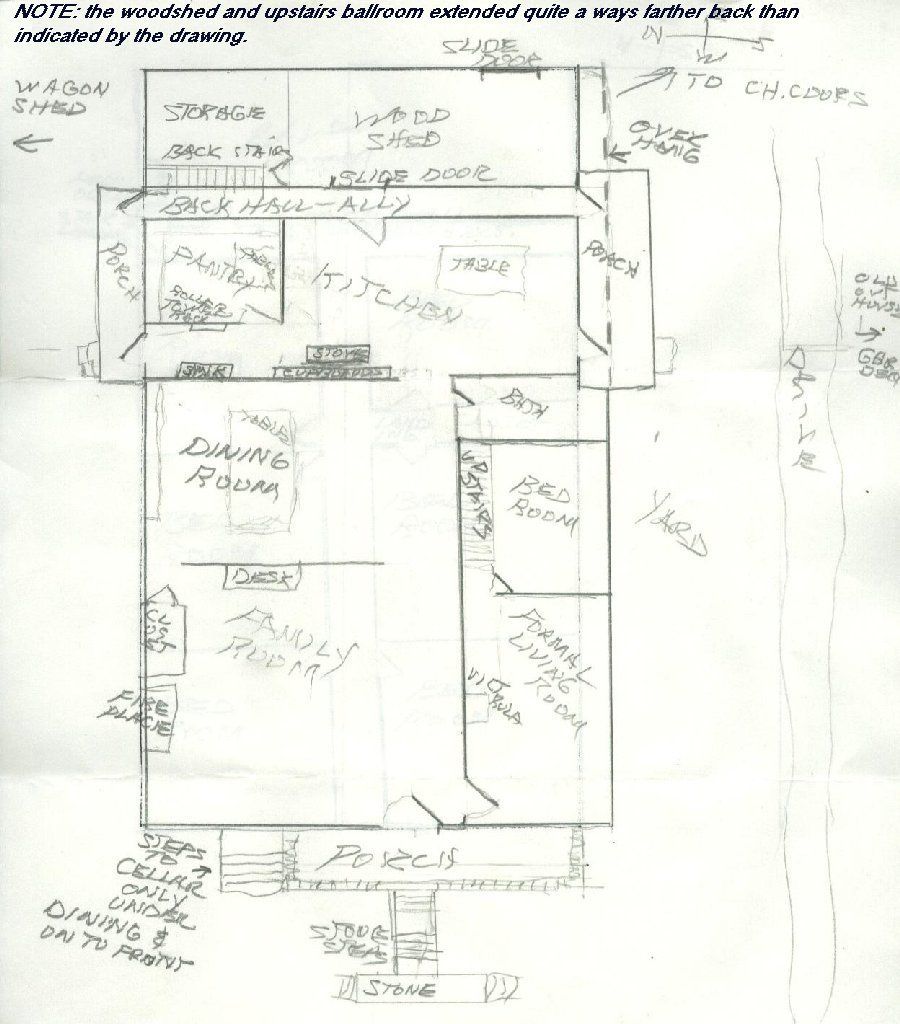
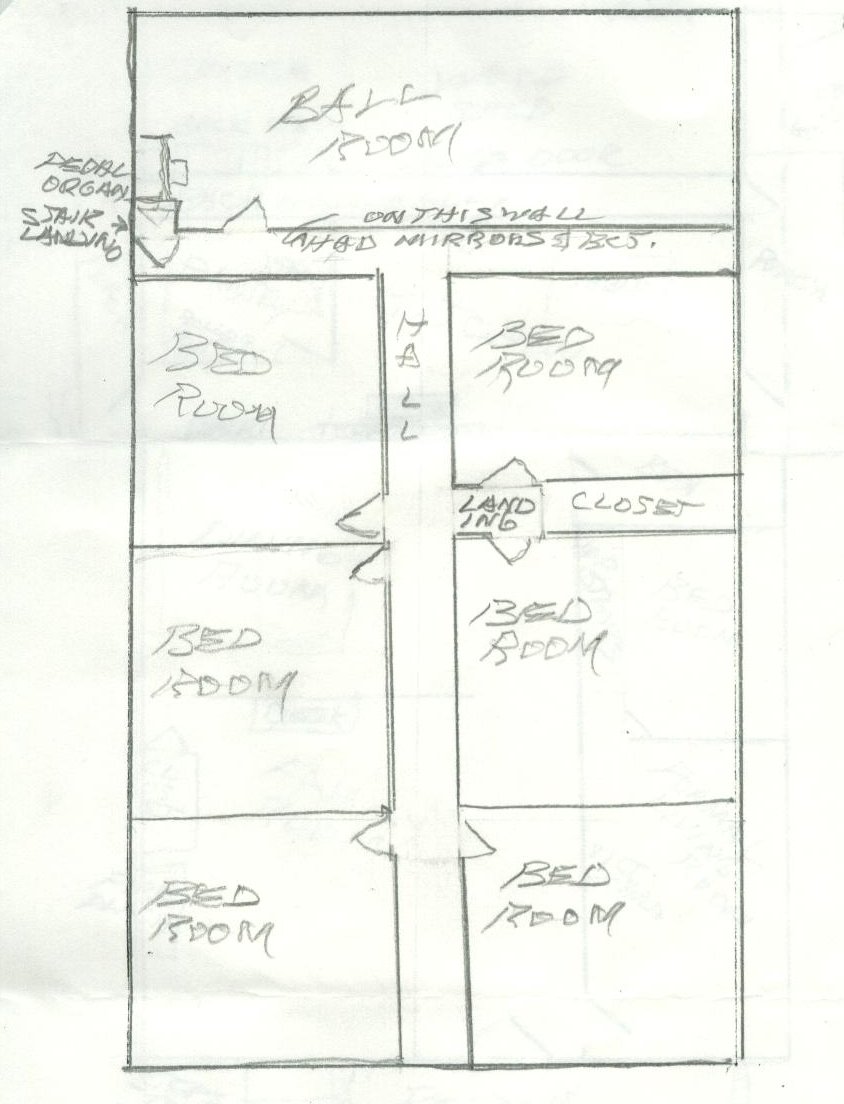
Jim and I talked of the "pot belly stove" my mother mentioned. He elaborated upon it, and it would more properly considered a "parlor stove" It burned coal, and was large enough to hold two scuttles full. He drew a picture of it, below.
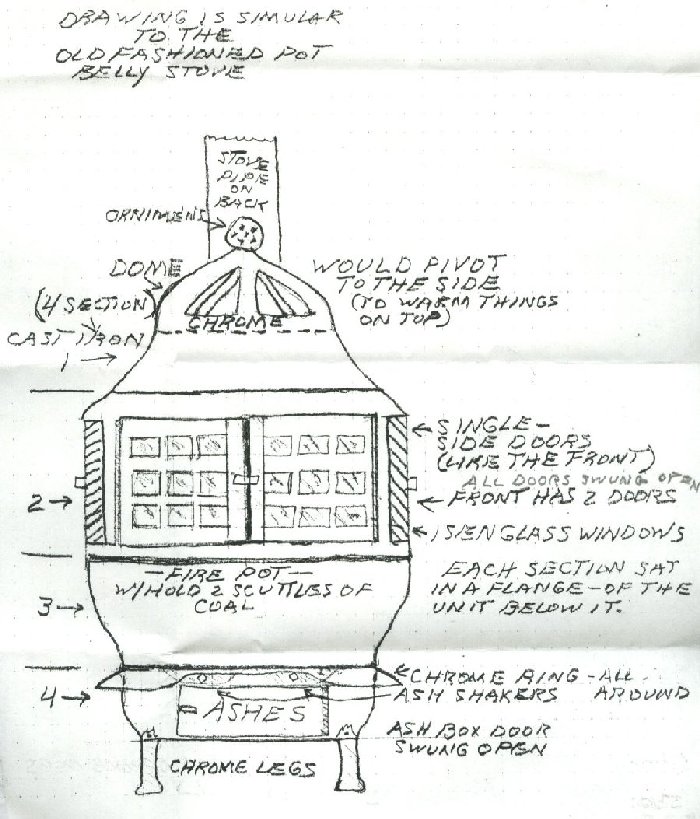
We talked of heat prior to the time of coal, and he spoke of a "floor furnace"; a large stove in the cellar which vented straight up into the front room through a grating... Cold air would return to the basement through vents along the exterior walls of the house. Elegant in its simplicity, but hardly an even heat by today's standards.
He recalled "Grandpa sitting next to the vent and spitting tobacco down the grating and onto the top of the stove. It would stink, Grandma would yell, and grandpa would smile" On second recollection he decided that it was his grandfather James Stoll who had the floor furnace.
We were unable to establish what preceded the parlor stove. The access to the cellar was through a set of outdoor steps at the front of the house, so a wood- fired floor furnace was unlikely. There was a fireplace in the family room, but fireplaces are notoriously inefficient. Probably the coal stove was preceded by a wood stove in the same location.
The kitchen stretched all the way across the back of the house and opened to porches on both sides as well as opening to the back "alley" and further access to the shed out back and the back stairs.
Jim spoke of coming in the north side of the kitchen, and the large double tub lead sink that was against the wall, on the right. He said that folks would pump some well water into the bowl and then dip some hot water from the stove reservoir into it to warm it. A roll towel was mounted on the opposite wall... You would roll it to a clean section, and after a few days you would roll it to the next-cleanest section!
Meals were served in the kitchen unless there was a "gathering", and the "formal living room" or parlor was used only for the most formal of occasions, funerals among them. Virginia's recollection was of Stanley and Frances living in the right (south) half of the house.
Jim's diagram shows a bathroom and also shows that the "old outhouse" was out the door to the south porch. He states that Fred and Stanley both installed running water in their homes in the mid 1930s, and that both houses were served from wells and pumps in the milk houses (Water obviously was necessary in the milk house but optional in the house!).
In each case the pumps were big clumsy "pull-rod" pumps... Pumps which were mounted over the well with a supply pipe, pump chamber, and a pull rod dropped down into it.. A half- horse motor ran a pair of pinion gears, each of which ran a large gear that drove an eccentric. A yoke connected the two eccentrics and connected to the pull rod. It ran slow, maybe 10 seconds to make a cycle.
When the leathers in the pump chambers wore out, the pump apparatus over the well had to be removed, the pump chamber, and the supply pipe and pull rod had to be pulled up out of the water. It was then disassembled to replace the leathers.
Water to the houses was supplied through iron pipes which went under the road, a run of about 150 feet in each case.
Jim said that nobody was ever too sick to work, "even if all you could do was go down to the barn and sweep cobwebs"... A broken leg would be worth a week or two "off". This gave rise to a conversation about the home medicine cabinet, which Jim said was mostly just a "repair station". It contained ointments for cuts scrapes and burns, and little medicine beyond aspirin (if that... he couldn't recall). The cabinet would also have sulphur, pine tar, cloves, cod- liver oil, sweet oil, camphor, linement, gauze and tape. Also a there might be bottle of 50-year old whiskey... Jim said he tried it once, and decided that he would never get sick enough to drink any more of it... Burned worse than moonshine. From the kitchen there was oatmeal, cider vinegar, salt, baking soda, and hot or cold compresses.
Colds were treated with cough medicine made from whiskey, honey and lemon juice. Also vapors from salves or cough medicines. He recalled Charley MacDougall's brother Harry smoking a pipe with juice running down his chin, making a batch of cough medicine.
Jim said that The Rawleigh Man, Dan Soper of Pine Valley, would stop by every few weeks selling salves ointments etcetera. From earlier years Bob Dann recollected a man who came through on a horse- drawn wagon selling kitchen and hardware items. The tin goods made such a clatter that he could be heard long before he was seen.
In the end, it was the heating system that was the ruin of the house; not uncommon in earlier years. In October of 1938 one of the women emptied the ashes too close to the shed- end of the house, and by the time anyone knew that the back of the house was on fire, it was too well- established to do anything about it. People from all around helped the families clean out the belongings from the house as the fire spread from the back- end into the living area. The house that presently occupies the site was built by the Dann family as a duplex, reflecting the fact that it had generally housed two families in recent years.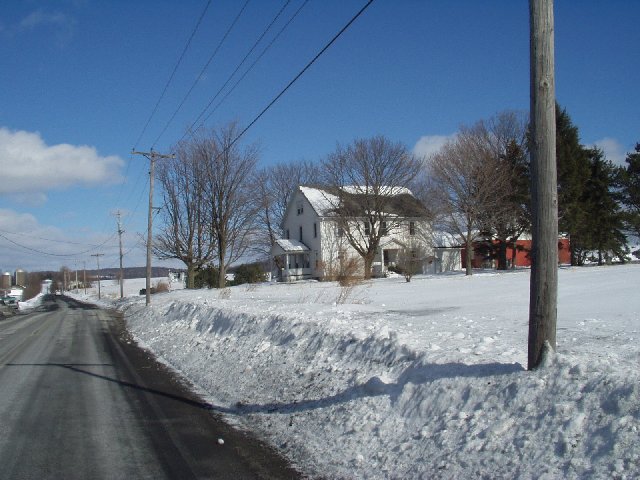
This house was built on the site of the "halfway house", the family home which burned in October of 1938. It is sometimes referred to as the "Vary Farm". Jim said it was halfway between Horseheads and Odessa, and that it had been a sort of a road house in years prior to 1916 when Fred purchased it. He said it was a great big house'with six or seven bedrooms and a big kitchen, dining room and pantry. In the back there was the "ballroom"; He does not recall it ever being used as such, but said thet there was a pump organ back there.
The fire broke out in the middle of the afternoon, after hot ashes had been dumped behind the woodshed. Jim said that the house was so long out back ...the entire first floor below the ballroom was woodshed, about 30 by 35... that the fire was quite well developed before anyone even had a hint of its existence. At the time that it burned, it had been split into a duplex, and was occupied by Donald, Gerald, and their families. Jim said that the layout of the house made it a very awkward split as a two family home, but that when it was replaced, it was laid out as a duplex.
After the fire Donald and Fran moved to the Tifft place. Gerald and Marion moved to Newfield with Marion's folks. They all moved back as soon as the new house was completed. Gerald moved to the Worden farm a short time later, and Donald operated the Vary farm himself. Steve Cortright (his family farmed on the Middle Road) rented the north side of the house.
Jim Dann relates the following story of the fire:
Ed Van Duzer was the superintendent of Veteran #10 school, (accross from
the Vary Cemerery) and drove up in his green model A Ford to say that
the Dann house was on fire, and he was getting neighbors to help fight
it. Jim thought that it was his house that was burning, and
immediately feared for a $37 check he had just received from showing his
Holstein heifer at the Chemung County Fair!
He (and others) ran up the hill and quickly saw that it was the halfway house that was on fire. Phoebe had taken Stanley up the road in the car, but he was unable to get around or see too well at this point (due to the injuries which eventually caused his death). Ed Van Duzer had returned and was carrying dishes out two at a time, one in each hand and putting them in the garden. (He didn't break any).
At the same time there were men upstairs handing furniture out the windows on the north side. He remembers in particular seeing them yell to Donald as they tossed a loaded cedar chest from the window... he caught it in his outstretched arms and two others then carried it to the garden.
This piece, as are most others, is a work in progress; 02 25 07.